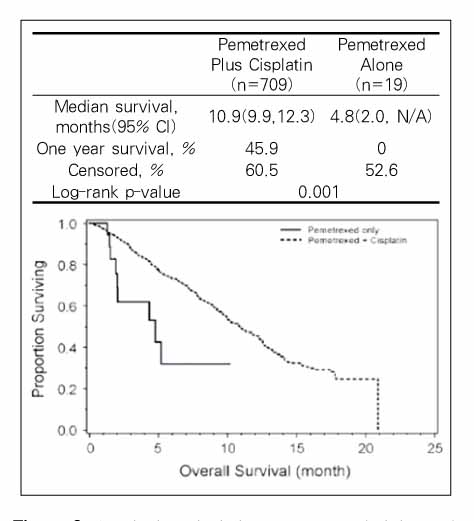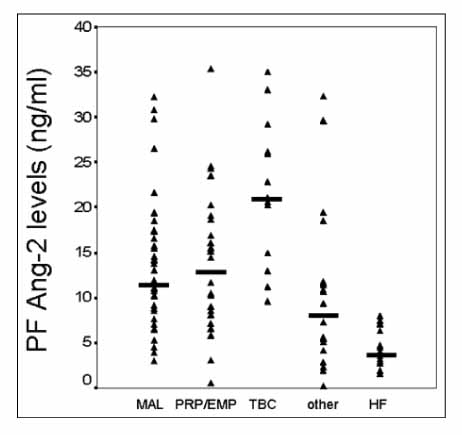Tuberc Respir Dis.
2007 Jun;62(6):469-478.
Pleural Disease
- Affiliations
-
- 1Department of Internal Medicine, Wonkwang Uneversity College of Medicine, Iksan, Korea. yshpul@wonkwang.ac.kr
Abstract
- No abstract available.
MeSH Terms
Figure
Reference
-
1. Davies RJ, Traill ZC, Gleeson FV. Randomised controlled trial of intrapleural streptokinase in community acquired pleural infection. Thorax. 1997. 52:416–421.2. Bouros D, Schiza S, Tzanakis N, Chalkiadakis G, Drositis J, Siafakas N. Intrapleural urokinase versus normal saline in the treatment of complicated parapneumonic effusions and empyema: a randomized, double blind study. Am J Respir Crit Care Med. 1999. 159:37–42.3. Tuncozgur B, Ustunsoy H, Sivrikoz MC, Dikensoy O, Topal M, Sanli M, et al. Intrapleural urokinase in the management of parapneumonic empyema: a randomized controlled trial. Int J Clin Pract. 2001. 55:658–660.4. Diacon AH, Theron J, Schuurmans MM, Van de Wal BW, Bolliger CT. Intrapleural streptokinase for empyema and complicated parapneumonic effusions. Am J Respir Crit Care Med. 2004. 170:49–53.5. Maskell NA, Davies CW, Nunn AJ, Hedley EL, Gleeson FV, Miller R, et al. U. K. Controlled trial of intrapleural streptokinase for pleural infection. N Engl J Med. 2005. 352:865–874.6. Tillett WS, Sherry S, Read CT. The use of streptokinase streptodornase in the treatment of postpneumonic empyema. J Thorac Surg. 1951. 21:275–297.7. Cameron R, Davies H. Intra-pleural fibrinolytic therapy versus conservative management in the treatment of parapneumonic effusions and empyema. Cochrane Database Syst Rev. 2004. 2:CD002312.8. Light RW, Nguyen T, Mulligan ME, Sasse SA. The in vitro efficacy of Varidase versus streptokinase or urokinase for liquefying thick purulent exudative material from loculated empyema. Lung. 2000. 178:13–18.9. Simpson G, Roomes D, Heron M. Effects of streptokinase and deoxyribonuclease on viscosity of human surgical and empyema pus. Chest. 2000. 117:1728–1733.10. Simpson G, Roomes D, Reeves B. Successful treatment of empyema thoraces with human recombinant deoxyribonuclease. Thorax. 2003. 58:365–366.11. Ayed AK. Suction versus water seal after thoracoscopy for primary spontaneous pneumothorax: prospective randomized study. Ann Thorac Surg. 2003. 75:1593–1596.12. Gossot D, Galetta D, Stern JB, Debrosse D, Caliandro R, Girard P, et al. Results of thoracoscopic pleural abrasion for primary spontaneous pneumothorax. Surg Endosc. 2004. 18:466–471.13. Lang-Lazdunski L, Chapuis O, Bonnet PM, Pons F, Jancovici R. Videothoracoscopic bleb excision and pleural abrasion for the treatment of primary spontaneous pneumothorax: long-term results. Ann Thorac Surg. 2003. 75:960–965.14. Margolis M, Gharagozloo F, Tempesta B, Trachiotis GD, Katz NM, Alexander EP. Video-assisted thoracic surgical treatment of initial spontaneous pneumothorax in young patients. Ann Thorac Surg. 2003. 76:1661–1664.15. Tschopp JM, Brutsche M, Frey JG. Treatment of complicated pneumothorax by simple talc pleurodesis under thoracoscopy and local anaesthesia. Thorax. 1997. 52:329–332.16. Cardillo G, Facciolo F, Regal M, Carbone L, Corzani F, Ricci A, et al. Recurrences following videothoracoscopic treatment of primary spontaneous pneumothorax: the role of redo-videothoracoscopy. Eur J Cardiothorac Surg. 2001. 19:396–399.17. Kennedy L, Sahn SA. Talc pleurodesis for the treatment of pneumothorax and pleural effusion. Chest. 1994. 106:1215–1222.18. Chen JS, Hsu HH, Chen RJ, Kuo SW, Huang PM, Tsai PR, et al. Additional minocycline pleurodesis after thoracoscopic surgery for primary spontaneous pneumothorax. Am J Respir Crit Care Med. 2006. 173:548–554.19. Chen JS, Hsu HH, Kuo SW, Tsai PR, Chen RJ, Lee JM, et al. Effects of additional minocycline pleurodesis after thoracoscopic procedures for primary spontaneous pneumothorax. Chest. 2004. 125:50–55.20. Yim AP, Liu HP. Video assisted thoracoscopic management of primary spontaneous pneumothorax. Surg Laparosc Endosc. 1997. 7:236–240.21. Sahn SA. Management of malignant pleural effusions. Monaldi Arch Chest Dis. 2001. 56:394–399.22. Heffner JE, Sahn SA, Brown LK. Multilevel likelihood ratios for identifying exudative pleural effusions. Chest. 2002. 121:1916–1920.23. Sahn SA. State of the art. The pleura. Am Rev Respir Dis. 1988. 138:184–234.24. Cheng D, Lee YC, Rogers JT. Vascular endothelial growth factor level correlates with transforming growth factor-beta isoform levels in pleural effustions. Chest. 2000. 118:1747–1753.25. Anderson CB, Philpott GW, Ferguson TB. The treatment of malignant pleural effusions. Cancer. 1974. 33:916–922.27. Groth G, Gatzemeier U, Haussingen K, Heckmayr M, Magnussen H, Neuhauss R, et al. Intrapleural palliative treatment of malignant pleural effusions with mitoxantrone versus placebo (pleural tube alone). Ann Oncol. 1991. 2:213–215.28. Genc O, Petrou M, Ladas G, Goldstraw P. The long-term morbidity of pleuroperitoneal shunts in the management of recurrent malignant effusions. Eur J Cardiothorac Surg. 2000. 18:143–146.29. Martini N, Bains MS, Beattie EJ Jr. Indications for pleurectomy in malignant effusion. Cancer. 1975. 35:734–738.30. Aelony Y. Dry talc pleurodesis via chest tube. Chest. 2003. 123:308.31. Aelony Y, King RR, Boutin C. Thoracoscopic talc poudrage in malignant pleural effusions: effective pleurodesis despite low pleural pH. Chest. 1998. 113:1007–1012.32. Crnjac A. The significance of thoracoscopic mechanical pleurodesis for the treatment of malignant pleural effusion. Wien Klin Wochenschr. 2004. 116:S28–S32.33. Ong KC, Indumathi V, Raghuram J, Ong YY. A comparative study of pleurodesis using talc slurry and bleomycin in the management of malignant pleural effusions. Respirology. 2000. 5:99–103.34. Chella A, Ribechini A, Dini P, Adamo C, Mussi A, Angeletti CA. Treatment of malignant pleural effusion by percutaneous catheter drainage and chemical pleurodesis. Minerva Chir. 1994. 49:1077–1082.35. Cheng D, Chan YM, Ng TY, Cheung AN, Ngan HY, Wong LC. Mitomycin chemotherapeutic pleurodesis to palliate malignant pleural effusions secondary to gynecological cancer. Acta Obstet Gynecol Scand. 1999. 78:443–446.36. Martinez-Moragon E, Aparicio J, Rogado MC, Sanchis J, Sanchis F, Gil-Suay V. Pleurodesis in malignant pleural effusions: a randomized study of tetracycline versus bleomycin. Eur Respir J. 1997. 10:2380–2383.37. Putnam JB Jr, Light RW, Rodriguez RM, Ponn R, Olak J, Pollak JS, et al. A randomized comparison of indwelling pleural catheter and doxycycline pleurodesis in the management of malignant pleural effusions. Cancer. 1999. 86:1992–1999.38. Tanaka N, Takazawa K, Fujita M, Tamura S, Odani Y, Hirayama Y, et al. Adult case of isolated noncompaction of left ventricular myocardium revealed at hospitalization for tuberculous pleuritis. J Cardiol. 1999. 33:169–174.39. Rosso R, Rimoldi R, Salvati F, De Palma M, Cinquegrana A, Nicolò G, et al. Intrapleural natural beta interferon in the treatment of malignant pleural effusions. Oncology. 1988. 45:253–256.40. Lissoni P, Mandala M, Curigliano G, Ferretti G, Moro C, Ardizzoia A, et al. Progress report on the palliative therapy of 100 patients with neoplastic effusions by intracavitary low-dose interleukin-2. Oncology. 2001. 60:308–312.41. Senyigit A, Bayram H, Babayigit C, Topcu F, Balci AE, Satici O. Comparison of the effectiveness of some pleural sclerosing agents used for control of effusions in malignant pleural mesothelioma: a review of 117 cases. Respiration. 2000. 67:623–629.42. Van Meerbeeck JP, Gaafar R, Manegold C, Van Klaveren RJ, Van Marck EA, Vincent M, et al. Randomized phase III study of cisplatin with or without raltitrexed in patients with malignant pleural mesothelioma: an intergroup study of the European organisation for research and treatment of cancer lung cancer group and the national cancer institute of Canada. J Clin Oncol. 2005. 23:6881–6889.43. Vogelzang NJ, Rusthoven JJ, Symanowski J, Denham C, Kaukel E, Ruffie P, et al. Phase III study of pemetrexed in combination with cisplatin versus cisplatin alone in patients with malignant pleural mesothelioma. J Clin Oncol. 2003. 21:2636–2644.44. Castagneto B, Zai S, Dongiovanni V, Manzin E, Clerico M, Botta M. Cisplatin and gemcitabine in malignant pleural mesothelioma: a phase study. Proc Am Soc Clin Oncol. 2003. 22:656. [abstract 2637].45. Portalone L, Antilli A, Nunziati F, Crispino C, Demarinis F, Friggeri L, et al. Epirubicin and gemcitabine as first-line treatment in malignant pleural mesothelioma. Tumori. 2005. 91:15–18.46. Ceresoli G, Zucali P, Favaretto A, Grossi F, Bidoli P, Del Conte G, et al. A phase study of pemetrexed and carboplatin as first-line chemotherapy in patients with malignant pleural mesothelioma (MPM). Proc Am Soc Clin Oncol. 2005. 7172. [abstract].47. Fennell DA, C Steele JP, Shamash J, Sheaff MT, Evans MT, Goonewardene TI, et al. Phase II trial of vinorelbine and oxaliplatin as first-line therapy in malignant pleural mesothelioma. Lung Cancer. 2005. 47:277–281.48. Grove CS, Lee YC. Vascular endothelial growth factor: the key mediator in pleural effusion formation. Curr Opin Pulm Med. 2002. 8:294–301.49. Roberts WG, Palade GE. Increased microvascular permeability and endothelial fenestration induced by vascular endothelial growth factor. J Cell Sci. 1995. 108:2369–2379.50. Hamed EA, El-Noweihi AM, Mohamed AZ, Mahmoud A. Vasoactive mediators (VEGF and TNF-α) in patients with malignant and tuberculous pleural effusions. Respirology. 2004. 9:81–86.51. Sack U, Hoffmann M, Zhao XJ, Chan KS, Hui DS, Gosse H, et al. Vascular endothelial growth factor in pleural effusions of different origin. Eur Respir J. 2005. 25:600–604.52. Yano S, Shinohara H, Herbst RS, Kuniyasu H, Bucana CD, Ellis LM, et al. Production of experimental malignant pleural effusions is dependent on invasion of the pleura and expression of vascular endothelial growth factor/vascular permeability factor by human lung cancer cells. Am J Pathol. 2000. 157:1893–1903.53. Yano S, Herbst RS, Shinohara H, Knighton B, Bucana CD, Killion JJ, et al. Treatment for malignant pleural effusion of human lung adenocarcinoma by inhibition of vascular endothelial growth factor receptor tyrosine kinase phosphorylation. Clin Cancer Res. 2000. 6:957–965.54. Roviezzo F, Tsigkos S, Kotanidou A, Bucci M, Brancaleone V, Cirino G, et al. Angiopoietin-2 causes inflammation in vivo by promoting vascular leakage. J Pharmacol Exp Ther. 2005. 314:738–744.
- Full Text Links
- Actions
-
Cited
- CITED
-
- Close
- Share
- Similar articles
-
- Diagnostic Thoracoscopy in the Pleural Effusion
- Diagnostic Tools of Pleural Effusion
- Pleural Effusion in Cardiovascular Disease
- Pleural Calcification as a Manifestation of Paragonimiasis: A Report of Two Cases
- The Utility of Pleural Adenosine Deaminase for Diagnosis of Differentiating Tuberculous Pleural Effusion in Children




